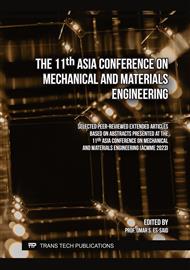p.3
p.11
p.17
p.23
p.31
p.37
p.45
p.59
p.67
Finite Element Analysis on Comparative Hyperelastic Material for CTSIB Foam
Abstract:
The objective of this research is to investigate the properties of standardized foam materials in clinical balance testing, assuming that the behavior of the foam material is hyperelastic. To simulate the deformation behavior, the finite element method was used in conjunction with the behavior of hyperelastic materials. We perform a value of the properties of materials without the use of destructive compression testing samples. Compression tests were performed on real materials according to standardized test methods that did not cause the destruction of the actual material. The collected data were then used to generate stress-strain relationship curves and compare them with different behavior models of hyperelastic materials using the finite element method. The behavior model of Ogden hyperelastic materials showed the highest similarity to the behavior of foam materials.
Info:
Periodical:
Pages:
31-36
Citation:
Online since:
December 2023
Keywords:
Price:
Сopyright:
© 2023 Trans Tech Publications Ltd. All Rights Reserved
Share:
Citation:



